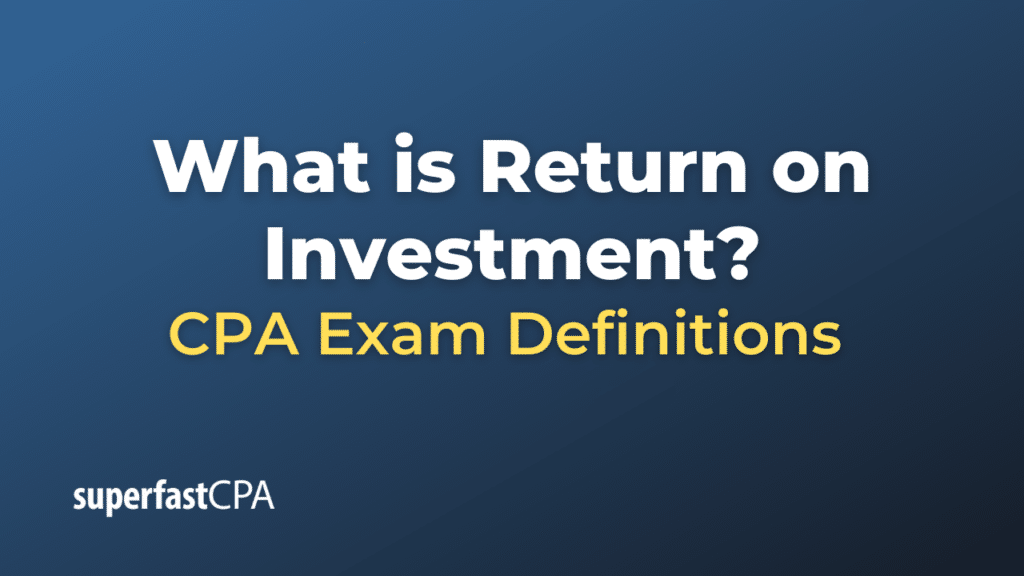Return on Investment
Return on Investment (ROI) is a widely used financial metric that measures the profitability of an investment relative to its cost. It provides a percentage representation of the return on an investment, making it a straightforward tool to compare the efficiency of different investments.
The formula for ROI is:
ROI = Net Profit from the Investment − Cost of the Investment / Cost of the Investment × 100%
Where:
- Net Profit from the Investment refers to the gain from the investment after all associated costs have been deducted.
- Cost of the Investment is the initial amount invested or the cost incurred to make the investment.
The outcome of the formula gives a percentage, which indicates how much return you received for every dollar invested. A positive ROI indicates that the investment has gained value, while a negative ROI indicates a loss.
For example, if you invest $1,000 in a venture and receive $1,200 back after selling your stake, your net profit is $200. The ROI would be:
ROI = 200 / 1000 × 100% = 20%
This means you earned a 20% return on your initial investment.
Benefits of Using ROI:
- Simplicity: It provides a quick snapshot of the profitability of an investment without getting into complex financial analyses.
- Versatility : It can be used to evaluate the return on virtually any type of investment, from stocks and real estate to marketing campaigns and equipment purchases.
- Comparative Analysis: It’s a standardized measure, so you can use it to compare the effectiveness of different investments directly.
Limitations of ROI:
- Lacks Time Dimension: ROI doesn’t take into account the time period over which the return was generated. An investment yielding a 20% ROI over one year is better than another investment yielding the same ROI over five years.
- Doesn’t Account for Risk : Two investments might have the same ROI, but one might be riskier than the other.
- Oversimplified: For complex investments, a simple ROI calculation might not capture all relevant costs or benefits.
Given its simplicity, ROI is a foundational tool in finance and investing. However, it’s essential to combine it with other metrics and qualitative factors to make informed decisions.
Example of Return on Investment
Let’s illustrate the concept of Return on Investment (ROI) using a simple example.
Scenario: Real Estate Investment
Suppose you purchase a house to rent out and then sell at a profit in the future.
Initial Purchase Price of the House: $300,000
Renovation Costs: $20,000
Total Investment Cost: $300,000 + $20,000 = $320,000
After renting it out for a few years, you decide to sell the house.
Selling Price of the House: $380,000
Total Rental Income over the years: $60,000
Maintenance & other costs over the years: $20,000
Net Profit from Rental: $60,000 – $20,000 = $40,000
Now, when you sell the house, your total return (from the sale and rental income) is: $380,000 (sale price) + $40,000 (net rental income) = $420,000.
Your net profit from the entire investment is:
Net Profit = Total Return – Total Investment Cost
Net Profit = $420,000 – $320,000 = $100,000
Now, to calculate the ROI:
ROI = Net Profit from the Investment−Cost of the Investment / Cost of the Investment × 100%
ROI = 100,000 / 320,000 × 100%
ROI = 31.25%
Analysis:
This result means that you earned a return of 31.25% on your initial investment of $320,000. For every dollar you invested in the property, you received a profit of $0.3125 (or 31.25 cents) in addition to your initial dollar back.
This example demonstrates the basic concept of ROI in the context of a real estate investment. However, remember that in real-world scenarios, other factors like market conditions, interest rates on any borrowed money, property taxes, and various other elements can influence the final ROI calculation. It’s crucial to consider all relevant costs and incomes to get an accurate measure.













